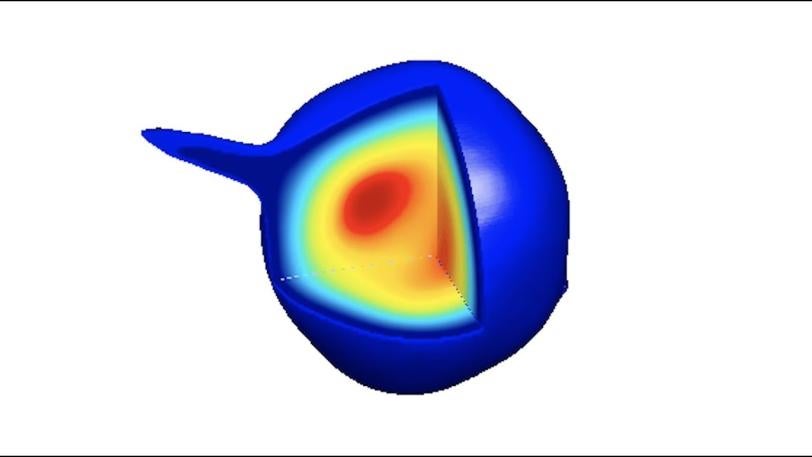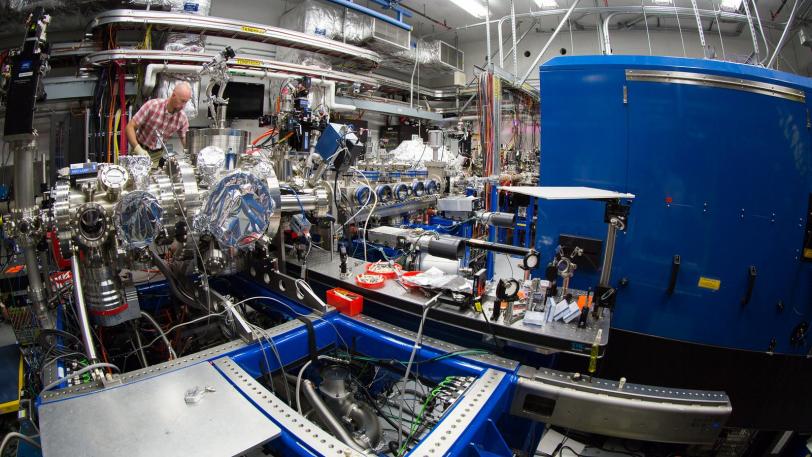Researchers Create Molecular Movie of Virus Preparing to Infect Healthy Cells
With SLAC’s X-ray laser, scientists captured a virus changing shape and rearranging its genome to invade a cell.
By Amanda Solliday
A research team has created for the first time a movie with nanoscale resolution of the three-dimensional changes a virus undergoes as it prepares to infect a healthy cell. The scientists analyzed thousands of individual snapshots from intense X-ray flashes, capturing the process in an experiment at the Department of Energy’s SLAC National Accelerator Laboratory.
Nature Methods published the results of the analysis on August 14. The collaboration included scientists from the University of Wisconsin-Milwaukee, Arizona State University, Brookhaven National Laboratory and SLAC.
This experiment is part of a broader, international Single Particle Imaging research effort launched by SLAC in 2015. The research team used a published open source data set provided by this initiative, and applied a complex and innovative analysis on the existing data called “manifold based analysis.” This same approach is used in analyzing facial expression based on changes in contours of the face.
The movie they created based on the data showed that the virus rearranges its genetic material and forms a tubular structure to empty its own DNA into a host cell.
To see this, the researchers examined more than 100,000 snapshots of the PR772 virus, which infects bacteria. Bright X-ray pulses from SLAC’s Linac Coherent Light Source (LCLS) hit the virus and scattered in a pattern that provided data needed for mathematical reconstruction. The researchers developed new, powerful algorithms to reconstruct the sequence of the images from the large volume of data.

UWM researchers create first 3-D video of a virus in action
"Not only does this research demonstrate a 3-D movie of the PR772 bacteriophage, it also demonstrates the single particle imaging method to a resolution of 10 nanometers. This resolution is nearly an order of magnitude better then what has been previously achieved,” says Andy Aquila, SLAC scientist and one of the publication’s co-authors.
The researchers discovered that the reorganization of the virus’s genome and the formation of a tubular structure are part of a concerted simultaneous process.
“In the past, scientists have tried to infer what’s happening in a molecular-scale biological process by looking at a still photo at the start and a still photo at the end of a process,” said Abbas Ourmazd, UWM professor and co-author of the paper. “But you then don’t know what happens in between. With this method, we are in a position to watch biological machines perform their functions.”
The work will help scientists better understand diseases caused by viruses and could lead to improved therapies.
“Single particle imaging using free-electron lasers requires that every particle is identical in shape and size,” says SLAC scientist Chun Hong Yoon, another member of the research team. “We chose to look at this virus because we thought the individual viruses would look the same to us. It was a total surprise when the UWM researchers told us that, during the experiment, these viruses may have been undergoing changes in shape.”
The study authors hope to apply the methods developed during this experiment to similar research that examines living processes at the atomic-scale, using large datasets generated during studies at X-ray free-electron lasers.
LCLS is a DOE Office of Science User Facility. The DOE Office of Science and the National Science Foundation funded this research.
Editor’s note: This article is based on a press release from the University of Wisconsin-Milwaukee.
Citation: Hosseinizadeh et al., Nature Methods, 14 August 2017 (10.1038/nmeth.4395)
Contact
For questions or comments, contact the SLAC Office of Communications at communications@slac.stanford.edu.
SLAC is a multi-program laboratory exploring frontier questions in photon science, astrophysics, particle physics and accelerator research. Located in Menlo Park, Calif., SLAC is operated by Stanford University for the U.S. Department of Energy's Office of Science.
SLAC National Accelerator Laboratory is supported by the Office of Science of the U.S. Department of Energy. The Office of Science is the single largest supporter of basic research in the physical sciences in the United States, and is working to address some of the most pressing challenges of our time. For more information, please visit science.energy.gov.





